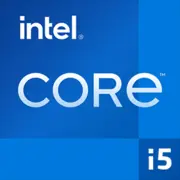Intel Core i5-3439Y

Intel Core i5-3439Y: ウルトラブック向けコンパクトプロセッサの回顧
(2025年4月)
アーキテクチャとプロセス技術: アイビー・ブリッジの遺産
2013年に発売されたIntel Core i5-3439Yプロセッサは、アイビー・ブリッジアーキテクチャの第3世代に属しています。これは、22nmプロセス技術に移行した最初のIntelの製品ラインの1つであり、消費電力を低減し、熱特性を改善することが可能になりました。
- コアとスレッド: 物理コア2つ、ハイパースレッディングをサポート(4スレッド)。
- クロック周波数: ベースクロック1.5GHz、ターボモード最大2.3GHz。
- グラフィックス: 統合GPUのIntel HD Graphics 4000は、16の実行ユニット(EU)を持ち、周波数は350〜850MHzです。
アイビー・ブリッジアーキテクチャは、マルチスレッドの最適化とSandy Bridgeと比較してIPC(サイクル毎命令)の5〜10%の改善をもたらしました。HD 4000統合グラフィックスは、前世代のHD 3000よりも20〜30%速く、DirectX 11およびOpenGL 4.0のサポートが追加されました。
消費電力とTDP: 薄型デバイス向けのバランス
プロセッサのTDPは13Wであり、超低電圧(Yシリーズ)カテゴリーに分類されます。これにより、ウルトラブック、タブレット、パッシブまたはコンパクトなアクティブ冷却を搭載したハイブリッドデバイスでの使用が可能になりました。
- 熱管理: ピーク負荷時でもプロセッサはオーバーヒートせず、しかしコンパクトなケースでは、10〜15分の稼働後にスロットリング(クロック周波数の低下)が発生する可能性があります。
- エネルギー効率: 22nmプロセス技術と電力の最適化により、アイドル時の消費電力は2〜3Wに減少しました。
パフォーマンス: 実際のタスクでのチップの能力は?
オフィス作業: Word、Excel、ブラウジング(5〜10タブ)には十分でした。Zoomとドキュメントの同時起動では70〜90%の負荷がかかりましたが、ラグはありませんでした。
メディア再生: フルHDビデオの再生は問題なく、10分の動画をHandbrakeで変換するのに約25分かかりました。
ゲーム: 統合GPU HD 4000は、2010〜2013年のゲームを低設定で処理しました:
- CS:GO — 25〜35 FPS(720p);
- Skyrim — 20〜25 FPS(720p、低設定);
- 2025年の最新ゲーム、たとえばHades IIなどは起動しません。
ターボブースト: シングルスレッドタスクでは周波数が2.3GHzに上昇しましたが、マルチスレッドタスクでは2.0GHzまで下がりました。パフォーマンスの向上は最大15%に達しました。
使用シナリオ: 2025年に誰に向いているか?
- オフィス作業と学習: ドキュメント作成、オンラインコース、ビデオ通話。
- メディア消費: 映画視聴、ストリーミング、簡単な画像編集。
- セカンダリーデバイス: 旅行用の予算ノートパソコンやバックアップPC。
向いていないタスク: 動画編集、3Dモデリング、最新のゲーム。
バッテリー駆動時間: TDPが作業時間に与える影響は?
2013〜2015年の間、i5-3439Yを搭載したノートパソコン(例: Dell XPS 12)は、40〜50Whのバッテリーを装備しており、中程度の負荷で6〜7時間は稼働しました。2025年には、これらのデバイス(在庫に新しいものが残っている場合)は$300〜400で購入できるでしょうが、そのバッテリー駆動時間は現代のARMプロセッサを搭載したモデル(15〜20時間)には及びません。
省電力技術:
- Intel SpeedStep — クロックの動的変更;
- C状態 — 使用していないCPUブロックのオフ;
- Intel HD Graphicsによる周波数の適応スケーリング。
競合製品との比較: AMD、Intel、Apple
1. AMD A6-4455M (2012): 2コア、Radeon HD 7500G、TDP 17W。IPCでは劣るが、グラフィックスは10〜15%速い。
2. Intel Core i5-7Y57 (2016): 2コア、TDP 4.5W、最大クロック3.3GHz。より現代的で省エネ。
3. Apple M1 (2020): 8コア、TDP 10W。性能は4〜5倍高く、バッテリー寿命は2倍長い。
結論: 2025年には、i5-3439Yは洗練されたIntel N100(2023)やQualcomm Snapdragon X Elite(2024)の中でも旧式な選択肢となります。
長所と短所
強み:
- 低熱放出;
- 基本的なタスクには十分;
- 仮想化(VT-x)をサポート。
弱み:
- 2コアはマルチタスクのボトルネック;
- USB 3.1、Wi-Fi 6のサポートがない;
- 古い22nmプロセス技術。
ノートパソコン選びの推奨
2025年にi5-3439Y搭載のデバイスを検討している場合、次の点を確認してください:
1. デバイスタイプ: 1.5kg以下のウルトラブック(例: Lenovo Yoga 2 Pro)。
2. ディスプレイ: 解像度1080pのIPSパネル(それ以下ではありません)。
3. メモリとストレージ: 最低8GBのRAMと256GBのSSD。
4. 価格: 新しい在庫は$400を超えないこと。Intel N200搭載の現代の予算モデル($450〜600)を選ぶのが良いでしょう。
最終結論: Core i5-3439Yは誰に向いているか?
このプロセッサは2010年代初頭の遺物です。2025年においては以下のようにあたるチョイスとして適当です:
- 最も簡素な作業用の予算ソリューション;
- 古い技術を学ぶための実験用PC;
- 旅行用のバックアップデバイス。
主な利点: 低価格(新しいものを見つけた場合)とコンパクトであること。ただし、2025年に快適に作業するためには、Intel Alder Lake-U(2022)またはARMチップベースのノートパソコンを選ぶ方が良いでしょう。これらは同じ$500〜700でより良いバッテリー寿命とパフォーマンスを提供します。
アドバイス: i5-3439Yを長期使用用の技術に投資しないでください。2025年の市場では、低価格セグメントでもより良い選択肢が多くあります。
基本
CPUの仕様
メモリ仕様
GPUの仕様
その他
ベンチマーク
他のCPUとの比較
ソーシャルメディアで共有する
または当サイトへのリンクを追加
<a href="https://cputronic.com/ja/cpu/intel-core-i5-3439y" target="_blank">Intel Core i5-3439Y</a>